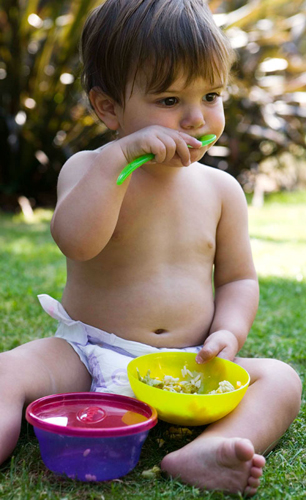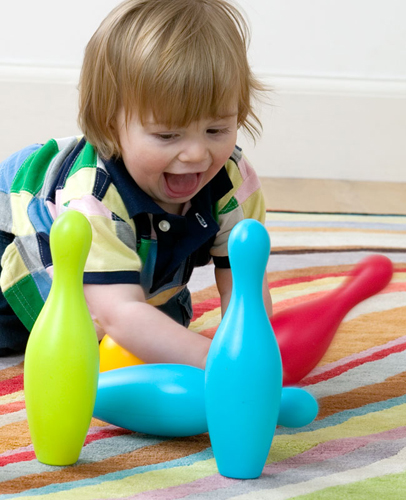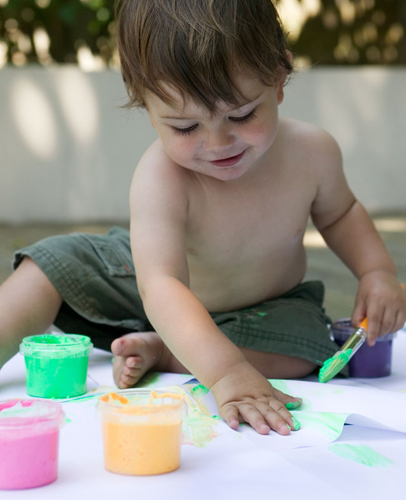At this age, your toddler’s life is a constant
adventure and full of the potential for fun. Every activity, journey,
movement, and sound he experiences is full of intrigue and excitement.
Play is a natural instinct that leads, inevitably, to him learning and
developing new skills.
The activities your
child enjoys naturally at 12–18 months will complement the areas of
growth and development that are accelerating at this time. For your
toddler, learning to walk and talk are the main priorities, along with
developing finer manipulative skills. A willingness to imitate a wealth
of other exciting activities, from sweeping and dusting to talking on
the telephone, is a sign that reasoning ability is developing.
Toys and games that encourage movement, language, and the development of fine motor skills are all ideal for this age group. Activities that involve as many of
the senses as possible will encourage healthy brain development and the
beginnings of memory.
Every young child needs
help and encouragement, but it is important to allow your child to
discover things at his own rate, rather than forcing the pace. Toddlers,
like adults, learn through experience. They need to be allowed to make
mistakes, in order to learn and develop their abilities.
Muscle control
The way your toddler begins to handle objects, such as a spoon,
and uses his thumb and fingers to grasp toys, is a sign of his
developing muscle control.

Toddler power
As your child learns “cause and effect”—that his actions can
influence his world—knocking down objects will become a favorite
activity. Needless to say, it’s better if he does this with his own
toys!

Choosing toys
Your toddler does not need
elaborate toys—normal household objects may often hold more delight and
are better suited to this age group than multifunctional toys. Simple
household items such as pots and pans, beans rattling in sealed
containers, and pieces of fabric, offer great scope for exploration, to
make sounds, or to enjoy textures and color.
“Can you find me a red
fruit?”/“Shall we put a hat on teddy?”/“Can you make a big splash in the
bath?”—everyday activities, such as getting dressed, brushing teeth,
bathing, shopping, and preparing food, all offer scope for fun and
games. Ask simple, direct questions that encourage your toddler to start
to recognize colors, shapes, and sounds, but keep it fun.
Games and rhymes
Young children love to
giggle and have a finely tuned sense of silliness. Finger games and
action rhymes are old favorites and the perfect way to nurture language
skills and coordination—especially if combined with a surprise ending.
Rhymes and singing encourage word skills and build confidence, and are a
great way to bond with your child, too.
Try these finger games and action rhymes:
Nursery rhymes and
songs that have been repeated for generations all have their value. A
favorite for helping children learn animal noises is Old MacDonald Had a Farm.
Itsy Bitsy Spider (climbed up the spout…).
This Little Piggy (went to market…).
Round and Round the Garden (like a teddy bear…).
The Wheels on the Bus (go round and round…).
Head, Shoulders, Knees, and Toes (knees and toes…).
Row, Row, Row Your Boat (gently down the stream…).
Humpty Dumpty (sat on the wall…).
Dance and music
Swing your toddler gently around as you sing along; balance him on your feet and dance with him.
Make
your own music using rattles, a horn, or a bell. Encourage your child
to make his own sounds and, within reason, don’t worry about censoring
the din.
There
are economically priced CDs and cassettes on the market that can
transform a rainy day or a tricky car trip into instant playtime.
Toys and activities
Your toddler may
repeat a simple action again and again, observing how something falls,
moves, or lights up. Toys that are too complex will either overstimulate
and lead to him “switching off” or, conversely, create a need for him
to be constantly entertained to tune in and learn.
He is developing the
ability to lead his own play, and although it will become more
pronounced during months 19–24 and beyond, if the signs are there,
encourage him as much as possible. Playtime is a wonderful time to be
with your child and, once the pattern is established, can become a great
habit and wonderful pastime for years to come.
Hand–eye coordination, reasoning, and fine motor skills:
Creative play
Painting is a fun activity that will help your child learn about
colors and improve his fine motor skills. Strip him down so that he can
be free to make a mess.

Things to puzzle over: simple jigsaws with knobs on the pieces, nesting toys that stack (rings and blocks).
Toys to build with: large building blocks, and to dig with: spade and sand.
Toys that flash, beep, and ring: simple cars, trucks, lights, and phones.
Toys to splash with: water, buckets, and bathtime toys.
Movement skills:
Toys to push and pull: toys on wheels, self-propelled cars and animals.
Games that involve movement and copying, such as Simon Says.
Helping your child learn:
Don’t overload him with complex instructions and elaborate toys.
Help him to figure things out (by hiding objects), to interact (by playing Peekaboo), and to fetch things.
Show encouragement and demonstrate the activity, but let him lead.
Allow
play with simple household objects—for example, a cardboard box, a
saucepan, or a laundry basket—to help develop your toddler’s imagination
through play.
“Hide and seek”: learning about “object permanence”
If your young toddler can
learn to understand that objects that are hidden still exist, he will
be closer to understanding that you still exist when you are not with
him. The knowledge will help to soothe his separation anxiety. Try the
following:
Choose a familiar toy or ball or other item and show it to your toddler.
Then hide it beneath a cushion or cup (or empty container) that is close by.
Next, lift the cushion or cup and show him where the object is hidden.
Use your voice, open your eyes wide, and smile to show surprise and pleasure at finding it, before covering the item again.
Then
encourage your child to seek the object out. (You may have to show him
what to do a few times first.) “Where has the blue ball gone?”/“Where is
the red sock?”
When he finds it make sure you pile on the praise so he knows that he has been very clever.
Then
do the same thing again. Once he has the hang of the game, try moving
the object and hiding it somewhere else nearby. With encouragement he
will gradually learn that hidden items still exist and that if you look
you may find them. It is the younger toddler’s version of Hide and Seek!!
A word to the wise
Young children love this game, and typically catch on quickly. However,
don’t feel compelled to rush him if he doesn’t: the concept of object
(and person) permanence develops on its own.